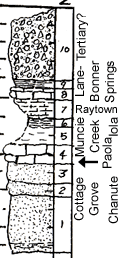
|
| Unit No. |
Description |
Thickness |
|
10
|
Gravel deposit to top of hill mostly of local origin, consisting of a heterogeneous mixture of olive gray to brown sandstones, light gray fossiliferous limestone, ironstone concretions, subangular to subrounded and varying in size from 1/8 to 4/5 inch
|
8 ft.
|
|
9
|
Shale - unfossiliferous, pale olive (10Y6/2), very slightly silty, poorly exposed
|
+ 1 ft.
|
|
8
|
Limestone - shaly, very fossiliferous, containing abundant crinoid remains; looks oolitic, yellowish gray (5Y7/2)
|
0.3 ft.
|
|
7
|
Shale - calcareous, very fossiliferous (dark yellowish gray), mainly crinoid remains
|
3 ft.
|
|
6
|
Shale - unfossiliferous, dark yellowish gray (5Y6/2), non-silty
|
0.5 ft.
|
|
5
|
Covered interval
|
2 ft.
|
|
4
|
Limestone - very fossiliferous and hard, weathers to dark yellowish orange(10YR6/6), grayish orange (10YR7/4) on broken surface. Has local clayey areas that weather into pitted or vuggy surface near top. Fossils consist predominantly of crinoid stems and small brachiopods, but also contains fenestellate bryozoans, Ostrea?, horn corals, and a few large brachiopods. Very fine crystalline
|
1.8 ft.
|
|
3
|
Sandstone - very fine grained, micaceous, very similar to lower sandstone below silicified bed, except massive. Uppermost 1/4 has fossils
|
2.7 ft.
|
|
2
|
Sandstone - very fine grained, silicified, no plants, few mica flakes, light gray (N7)
|
1.2 ft.
|
|
1
|
Sandstone - very fine grained, well sorted, subangular quartz grains and a few feldspar(?) grains. Mica flakes abundant. Loaded with plant fossils (leaves) in good condition. Very finely speckled with limonite. Very pale orange (10YR8/2). Bedding poor and variable in thickness both laterally and vertically and varies from 1/2 to 1.5 inches in thickness. Silty layers common near base of exposure
|
5.8 ft.
|
|


